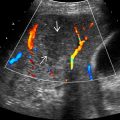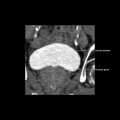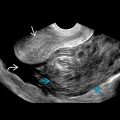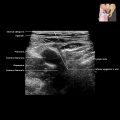KEY FACTS
Terminology
- •
Infection of humans caused by larval stage of Echinococcus granulosus or Echinococcus multilocularis
Imaging
- •
Best diagnostic clue: Membranes ± daughter cysts in complex heterogeneous mass
- •
E. granulosus
- ○
Anechoic cyst with double echogenic lines separated by hypoechoic layer
- ○
Honeycomb cyst, multiple septations
- ○
Water lily sign: Complete detachment of membrane
- ○
Snowstorm pattern: Anechoic cyst with internal debris and hydatid sand
- ○
- •
E. multilocularis
- ○
Single/multiple echogenic lesions
- ○
Irregular necrotic lesions with microcalcifications
- ○
Ill-defined infiltrative solid masses
- ○
Top Differential Diagnoses
- •
Hemorrhagic or infected cyst
- •
Complex pyogenic abscess
- •
“Cystic” metastases
- •
Biliary cystadenocarcinoma
Pathology
- •
Caused by larval stage of Echinococcus tapeworm
- ○
E. granulosus
- –
Most common form of hydatid disease, unilocular
- –
- ○
E. multilocularis
- –
Less common but aggressive
- –
- ○
Clinical Issues
- •
Serologic test positive in > 80% of cases
Diagnostic Checklist
- •
Rule out other complex or septate cystic liver masses
Scanning Tips
- •
Imaging clue: Daughter cysts can float freely within mother cyst
- •
Altering patient’s position may change position of daughter cysts
 with numerous peripheral daughter cysts, or scolices,
with numerous peripheral daughter cysts, or scolices,  within the right lobe of the liver.
within the right lobe of the liver.
 . The fibrous rim
. The fibrous rim  can be seen surrounding the cyst. (From DP: Spleen.)
can be seen surrounding the cyst. (From DP: Spleen.)
 and central heterogeneous content
and central heterogeneous content  in the left lobe of the liver. Note the posterior acoustic enhancement
in the left lobe of the liver. Note the posterior acoustic enhancement  .
.










